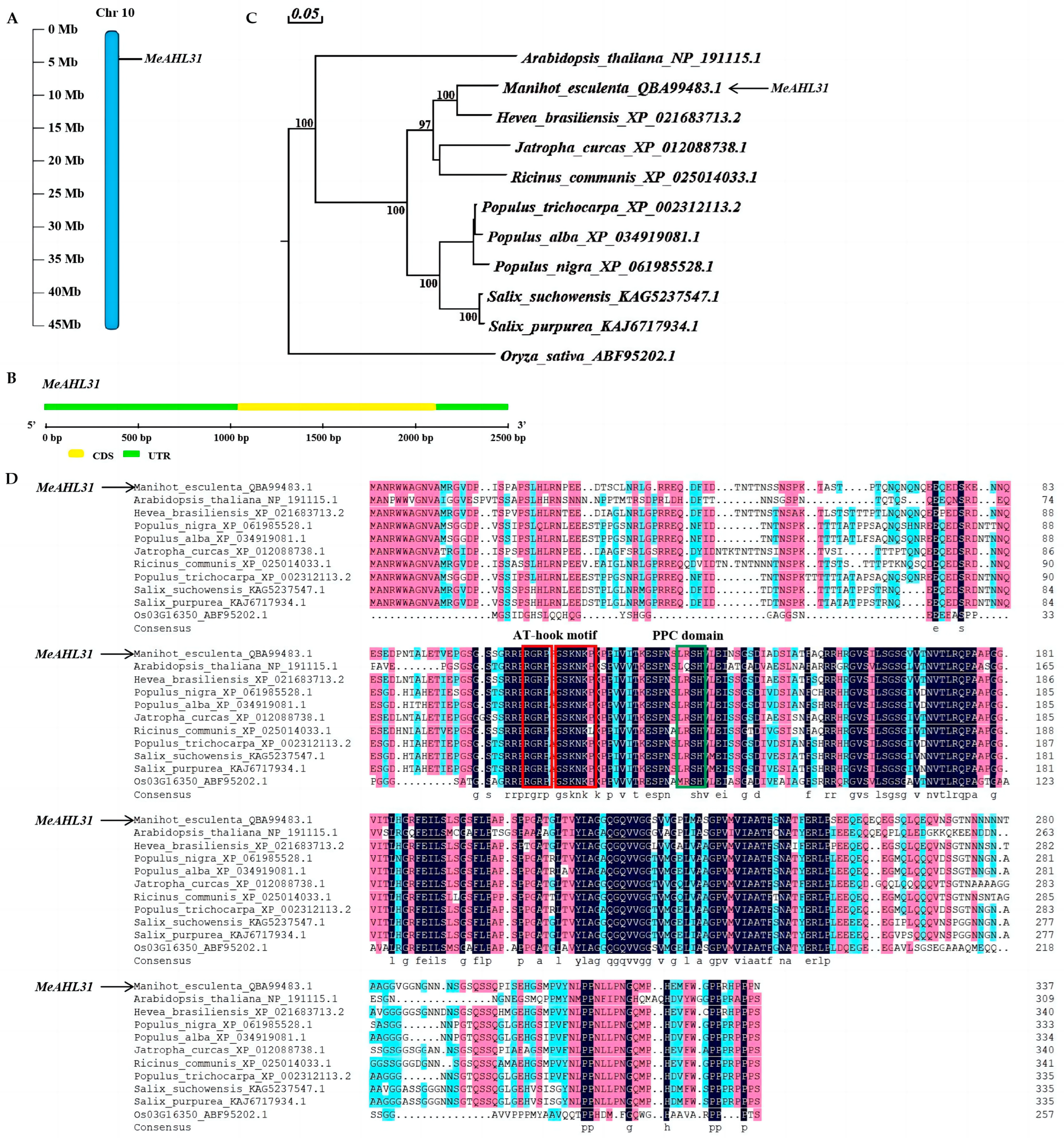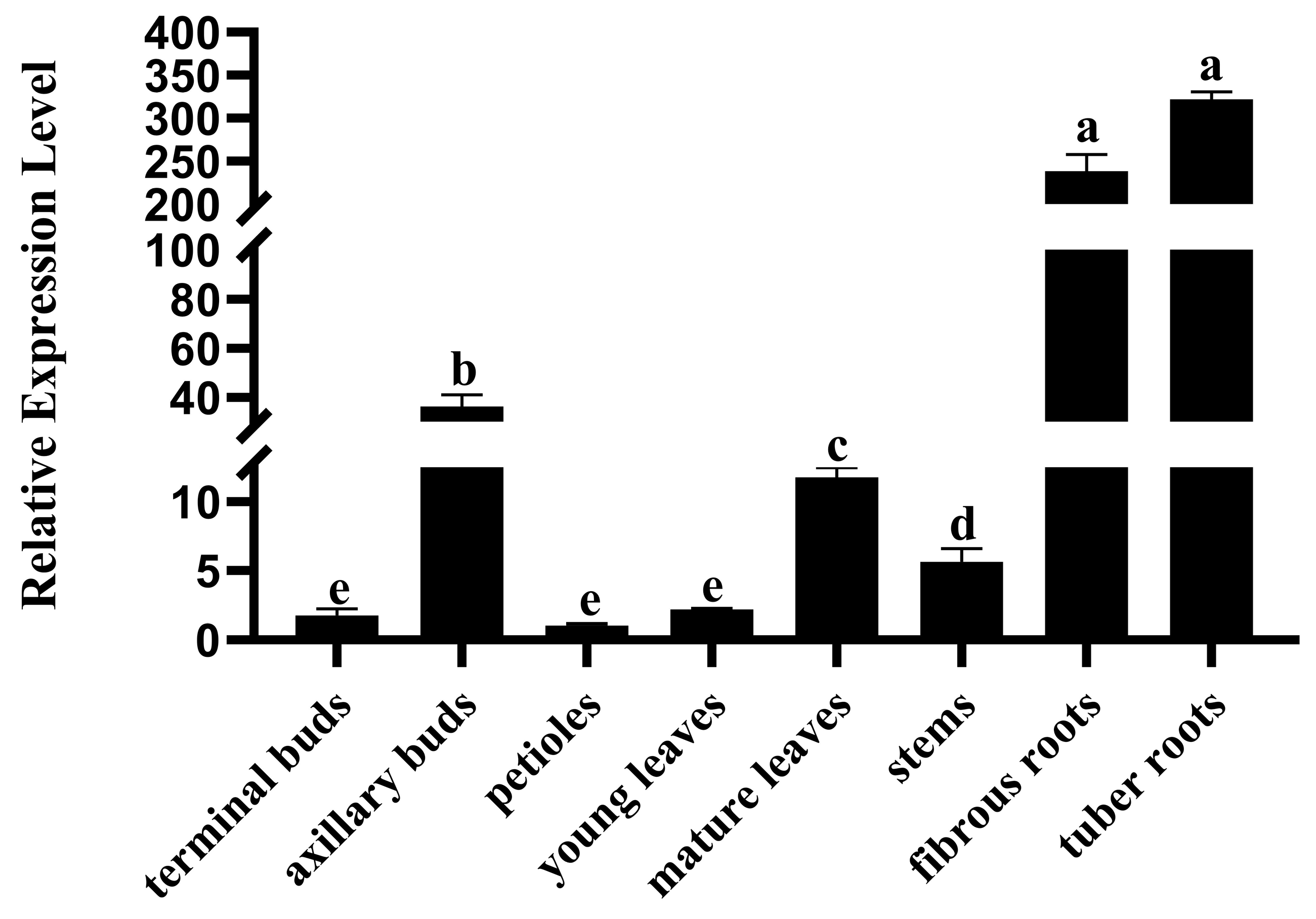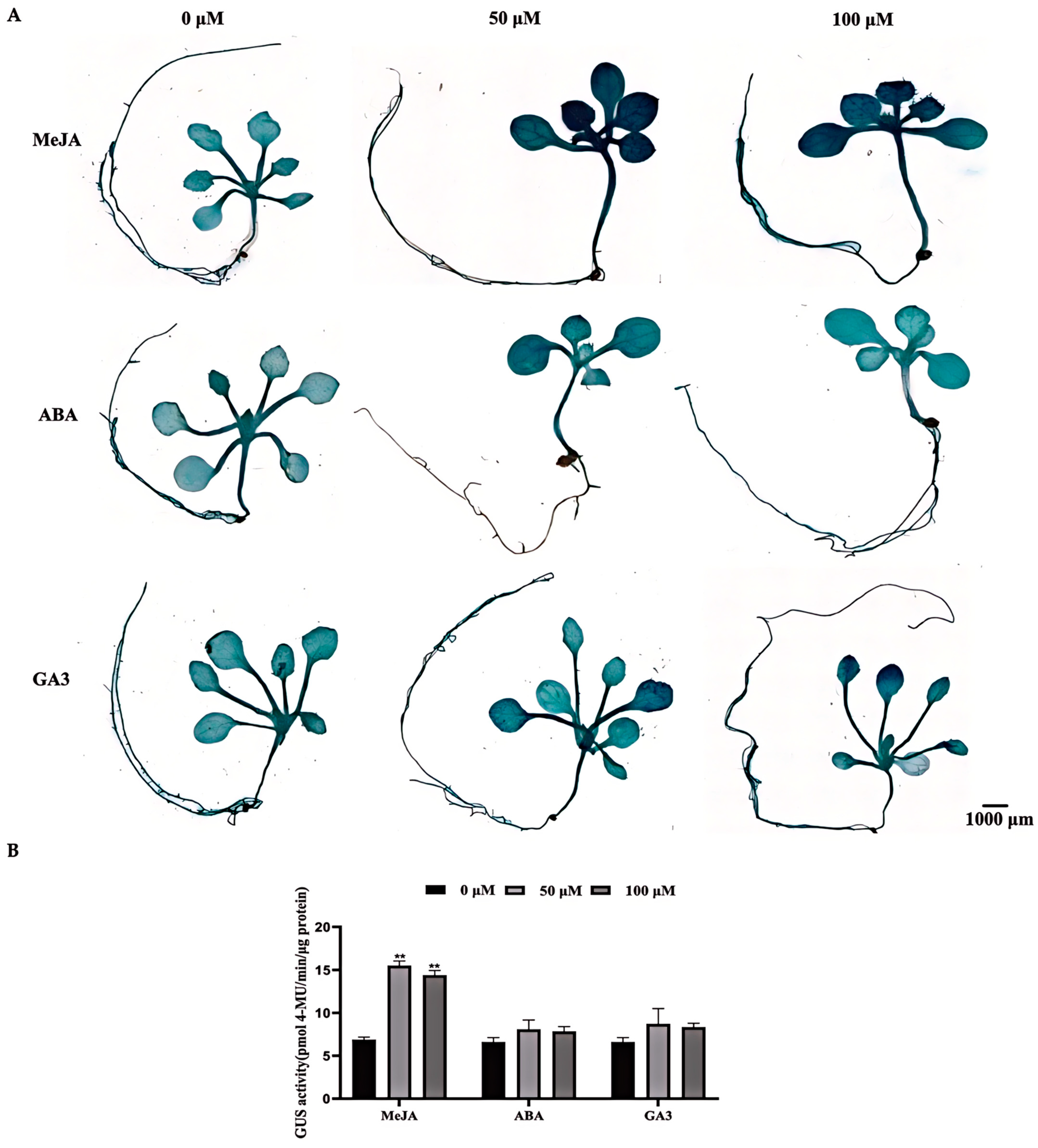Promoter of Cassava MeAHL31 Responds to Diverse Abiotic Stresses and Hormone Signals in Transgenic Arabidopsis
Abstract
1. Introduction
2. Results
2.1. Isolation and Characterization of MeAHL31
2.2. Subcellular Localization of MeAHL31 Protein
2.3. Expression Patterns of MeAHL31 in Cassava Tissues
2.4. Isolation and Cis-Acting Element Distribution of MeAHL31 Promoter
2.5. Expression Patterns of MeAHL31 Gene under Abiotic Stresses and Hormone Treatments
2.6. Histochemical Localization of MeAHL31 Promoter
2.7. Activities of MeAHL31 Promoter in Response to Salt and Drought Stresses
2.8. Activities of MeAHL31 Promoter in Response to MeJA, ABA, and GA3 Signals
3. Discussion
4. Materials and Methods
4.1. Plant Materials and Growth Conditions
4.2. Gene Structure and Phylogenetic Tree Analysis
4.3. DNA Extraction and Promoter Cloning of MeAHL31
4.4. Subcellular Localization of MeAHL31 Protein
4.5. Stress and Hormonal Treatments for Cassava
4.6. RNA Extraction and qRT-PCR Analysis for MeAHL31
4.7. Cis-Acting Element Analysis of MeAHL31 Promoter
4.8. Vector Construction of MeAHL31 Promoter and Generation of Transgenic Arabidopsis
4.9. Stress and Hormone Treatments for Transgenic Arabidopsis
4.10. GUS Staining and Activity Detection in Transgenic Arabidopsis
4.11. Statistical Analysis
Supplementary Materials
Author Contributions
Funding
Institutional Review Board Statement
Informed Consent Statement
Data Availability Statement
Conflicts of Interest
References
- Lebot, V. Tropical Root and Tuber Crops: Cassava, Sweet Potato, Yams and Aroids; Crop Production Science in Horticulture Series NO.17; Atherton, J., Rees, A., Eds.; CABI: Wallingford, UK, 2008; Volume 17, p. 404. [Google Scholar]
- Okogbenin, E.; Setter, T.L.; Ferguson, M.; Mutegi, R.; Ceballos, H.; Olasanmi, B.; Fregene, M. Phenotypic approaches to drought in cassava: Review. Front. Physiol. 2013, 4, 93–107. [Google Scholar] [CrossRef] [PubMed]
- Churchill, M.E.; Travers, A.A. Protein motifs that recognize structural features of DNA. Trends Biochem. Sci. 1991, 16, 92–97. [Google Scholar] [CrossRef] [PubMed]
- Zhao, J.; Favero, D.S.; Peng, H.; Neff, M.M. Arabidopsis thaliana AHL family modulates hypocotyl growth redundantly by interacting with each other via the PPC/DUF296 domain. Proc. Natl. Acad. Sci. USA 2013, 110, E4688–E4697. [Google Scholar] [CrossRef] [PubMed]
- Fujimoto, S.; Matsunaga, S.; Yonemura, M.; Uchiyama, S.; Azuma, T.; Fukui, K. Identification of a novel plant MAR DNA binding protein localized on chromosomal surfaces. Plant Mol. Biol. 2004, 56, 225–236. [Google Scholar] [CrossRef] [PubMed]
- Zhao, J.; Favero, D.S.; Qiu, J.; Roalson, E.H.; Neff, M.M. Insights into the evolution and diversification of the AT-hook motif nuclear localized gene family in land plants. BMC Plant Biol. 2014, 14, 266. [Google Scholar] [CrossRef]
- Jin, Y.; Luo, Q.; Tong, H.N.; Wang, A.J.; Cheng, Z.J.; Tang, J.F.; Li, D.Y.; Zhao, X.F.; Li, X.B.; Wan, J.M.; et al. An AT-hook gene is required for palea formation and floral organ number control in rice. Dev. Biol. 2011, 359, 277–288. [Google Scholar] [CrossRef] [PubMed]
- Kim, H.B.; Oh, C.J.; Park, Y.C.; Lee, Y.; Choe, S.; An, C.S.; Choi, S.B. Comprehensive analysis of AHL homologous genes encoding AT-hook motif nuclear localized protein in rice. BMB Rep. 2011, 44, 680–685. [Google Scholar] [CrossRef]
- Zhou, L.G.; Liu, Z.C.; Liu, Y.H.; Kong, D.Y.; Li, T.F.; Yu, S.W.; Mei, H.W.; Xu, X.Y.; Liu, H.Y.; Chen, L. A novel gene OsAHL1 improves both drought avoidance and drought tolerance in rice. Sci. Rep. 2016, 6, 30264. [Google Scholar] [CrossRef]
- Howden, A.J.M.; Stam, R.; Heredia, V.M.; Motion, G.B.; Have, S.T.; Hodge, K.; Amaro, T.M.M.M.; Huitema, E. Quantitative analysis of the tomato nuclear proteome during Phytophthora capsici infection unveils regulators of immunity. New Phytol. 2017, 215, 309–322. [Google Scholar] [CrossRef]
- Bishop, E.H.; Kumar, R.; Luo, F.; Saski, C.; Sekhon, R.S. Genome-wide identification, expression profiling, and network analysis of AT-hook gene family in maize. Genomics 2020, 112, 1233–1244. [Google Scholar] [CrossRef]
- Širl, M.; Šnajdrová, T.; Gutiérrez-Alanís, D.; Dubrovsky, J.G.; Vielle-Calzada, J.P.; Kulich, I.; Soukup, A. At-Hook motif nuclear localised protein 18 as a novel modulator of root system architecture. Int. J. Mol. Sci. 2020, 21, 1886. [Google Scholar] [CrossRef] [PubMed]
- Zhao, L.J.; Lu, Y.J.; Chen, W.; Yao, J.B.; Li, Y.; Li, Q.L.; Pan, J.W.; Fang, S.T.; Sun, J.; Zhang, Y.S. Genome-wide identification and analyses of the AHL gene family in cotton (Gossypium). BMC Genom. 2020, 21, 69. [Google Scholar] [CrossRef] [PubMed]
- Zhang, W.M.; Fang, D.; Chen, X.Z.; Cao, J.; Tan, X.L. Insights Into the Molecular Evolution of AT-Hook Motif Nuclear Localization Genes in Brassica napus. Front. Plant Sci. 2021, 12, 714305. [Google Scholar] [CrossRef] [PubMed]
- Wang, H.Z.; Leng, X.; Yang, J.; Zhang, M.Q.; Zeng, M.Z.; Xu, X.M.; Wang, F.D.; Li, C.H. Comprehensive analysis of AHL gene family and their expression under drought stress and ABA treatment in Populus trichocarpa. Peerj 2021, 9, e10932. [Google Scholar] [CrossRef]
- Wang, M.; Chen, B.W.; Zhou, W.; Xie, L.A.; Wang, L.S.; Zhang, Y.L.; Zhang, Q.Z. Genome-wide identification and expression analysis of the AT-hook motif nuclear localized gene family in soybean. BMC Genom. 2021, 22, 361–386. [Google Scholar] [CrossRef] [PubMed]
- Dahro, B.; Wang, Y.; Khan, M.; Zhang, Y.; Fang, T.; Ming, R.; Li, C.; Liu, J.H. Two AT-Hook proteins regulate A/NINV7 expression to modulate sucrose catabolism for cold tolerance in Poncirus trifoliata. New Phytol. 2022, 235, 2331–2349. [Google Scholar] [CrossRef]
- Favero, D.S.; Kawamura, A.; Shibata, M.; Takebayashi, A.; Jung, J.H.; Suzuki, T.; Jaeger, K.E.; Ishida, T.; Iwase, A.; Wigge, P.A.; et al. AT-Hook Transcription Factors Restrict Petiole Growth by Antagonizing PIFs. Curr. Biol. 2020, 30, 1454–1466. [Google Scholar] [CrossRef]
- Ambadas, D.A.; Singh, A.; Jha, R.K.; Chauhan, D.B.S.; Sharma, V.K. Genome-wide dissection of AT-hook motif nuclear-localized gene family and their expression profiling for drought and salt stress in rice (Oryza sativa). Front. Plant Sci. 2023, 14, 1283555. [Google Scholar] [CrossRef]
- Zhang, X.; Li, J.; Cao, Y.; Huang, J.; Duan, Q. Genome-Wide Identification and Expression Analysis under Abiotic Stress of BrAHL Genes in Brassica rapa. Int. J. Mol. Sci. 2023, 24, 12447. [Google Scholar] [CrossRef]
- Wang, L.; Li, T.; Liu, N.; Liu, X. Identification of tomato AHL gene families and functional analysis their roles in fruit development and abiotic stress response. Plant Physiol. Biochem. 2023, 202, 107931. [Google Scholar] [CrossRef]
- Tang, Y.; Wu, W.; Zheng, X.; Lu, L.; Chen, X.; Hao, Z.; Liu, S.; Chen, Y. AT-Hook Transcription Factors Show Functions in Liriodendron chinense under Drought Stress and Somatic Embryogenesis. Plants 2023, 12, 1353. [Google Scholar] [CrossRef]
- Zhang, H.; Zhu, J.; Gong, Z.; Zhu, J.K. Abiotic stress responses in plants. Nat. Rev. Genet. 2022, 23, 104–119. [Google Scholar] [CrossRef] [PubMed]
- Li, C.N.; Ng, C.K.Y.; Fan, L.M. MYB transcription factors, active players in abiotic stress signaling. Environ. Exp. Bot. 2015, 114, 80–91. [Google Scholar] [CrossRef]
- Hamamoto, K.; Fukaya, T. Molecular architecture of enhancer-promoter interaction. Curr. Opin. Cell Biol. 2022, 74, 62–70. [Google Scholar] [CrossRef]
- Zhou, S.; Du, G.; Kang, Z.; Li, J.; Chen, J.; Li, H.; Zhou, J. The application of powerful promoters to enhance gene expression in industrial microorganisms. World J. Microbiol. Biotechnol. 2017, 33, 23. [Google Scholar] [CrossRef]
- Nevoigt, E.; Fischer, C.; Mucha, O.; Matthäus, F.; Stahl, U.; Stephanopoulos, G. Engineering promoter regulation. Biotechnol. Bioeng. 2007, 96, 550–558. [Google Scholar] [CrossRef]
- Juven-Gershon, T.; Cheng, S.; Kadonaga, J.T. Rational design of a super core promoter that enhances gene expression. Nat. Methods 2006, 3, 917–922. [Google Scholar] [CrossRef]
- Yang, Y.; Lee, J.H.; Poindexter, M.R.; Shao, Y.; Liu, W.; Lenaghan, S.C.; Ahkami, A.H.; Blumwald, B.; Stewart, C.N., Jr. Rational design and testing of abiotic stress-inducible synthetic promoters from poplar cis-acting elements. Plant Biotechnol. J. 2021, 19, 1354–1369. [Google Scholar] [CrossRef] [PubMed]
- Ku, Y.S.; Sintaha, M.; Cheung, M.Y.; Lam, H.M. Plant Hormone Signaling Crosstalks between Biotic and Abiotic Stress Responses. Int. J. Mol. Sci. 2018, 19, 3206. [Google Scholar] [CrossRef]
- Wang, W.; Vinocur, B.; Altman, A. Plant responses to drought, salinity and extreme temperatures: Towards genetic engineering for stress tolerance. Planta 2003, 218, 1–14. [Google Scholar] [CrossRef]
- Sun, T.; Zhang, J.; Zhang, Q.; Li, X.; Li, M.; Yang, Y.; Zhou, J.; Wei, Q.; Zhou, B. Exogenous application of acetic acid enhances drought tolerance by influencing the MAPK signaling pathway induced by ABA and JA in apple plants. Tree Physiol. 2022, 42, 1827–1840. [Google Scholar] [CrossRef] [PubMed]
- Li, H.; Wang, J.Q.; Liu, Q. Photosynthesis product allocation and yield in sweet potato with spraying exogenous hormones under drought stress. J. Plant Physiol. 2020, 253, 153265. [Google Scholar]
- Wang, Y.Y.; Liu, J.; Wang, S.; Fu, S.P.; Li, R.M.; Yao, Y.; Hu, X.W.; Guo, J.C. Molecular cloning of cassava MeAHL31 gene and its expression and condition optimization in prokaryotic cells. Mol. Plant Breed. 2019, 17, 1430–1437. [Google Scholar]
- Panghal, A.; Munezero, C.; Sharma, P.; Chhikara, N. Cassava toxicity, detoxification and its foodapplications: A review. Toxin Rev. 2021, 40, 1–16. [Google Scholar] [CrossRef]
- Jia, P.; Liu, J.; Yan, R.; Yang, K.; Dong, Q.; Luan, H.; Zhang, X.; Li, H.; Guo, S.; Qi, G. Systematical Characterization of the AT-Hook Gene Family in Juglans regia L. and the Functional Analysis of the JrAHL2 in Flower Induction and Hypocotyl Elongation. Int. J. Mol. Sci. 2023, 24, 7244. [Google Scholar] [CrossRef] [PubMed]
- Waadt, R.; Seller, C.A.; Hsu, P.K.; Takahashi, Y.; Munemasa, S.; Schroeder, J.I. Plant hormone regulation of abiotic stress responses. Nat. Rev. Mol. Cell Biol. 2022, 23, 680–694. [Google Scholar] [CrossRef]
- Fujita, Y.; Fujita, M.; Satoh, R.; Maruyama, K.; Parvez, M.M.; Seki, M.; Hiratsu, K.; Ohme-Takagi, M.; Shinozaki, K.; Yamaguchi-Shinozaki, K. AREB1 is a transcription activator of novel ABRE-dependent ABA signaling that enhances drought stress tolerance in Arabidopsis. Plant Cell 2005, 17, 3470–3488. [Google Scholar] [CrossRef] [PubMed]
- Iqbal, M.; Ashraf, M. Gibberellic acid mediated induction of salt tolerance in wheat plants:growth, ionic partitioning, photosynthesis, yield and hormonal homeostasis. Environ. Exp. Bot. 2013, 86, 76–85. [Google Scholar] [CrossRef]
- Han, Z.; Zhang, C.; Zhang, H.; Duan, Y.; Zou, Z.; Zhou, L.; Zhu, X.; Fang, W.; Ma, Y. CsMYB tran-scription factors participate in jasmonic acid signal transduction in response to cold stress in tea plant (Camellia sinensis). Plants 2022, 11, 2869. [Google Scholar] [CrossRef] [PubMed]
- Xing, C.; Liu, Y.; Zhao, L.; Zhang, S.; Huang, X. A novel MYB transcription factor regulates ascorbic acid synthesis and affects cold tolerance. Plant Cell Environ. 2019, 42, 832–845. [Google Scholar] [CrossRef]
- Livak, K.J.; Schmittgen, T.D. Analysis of relative gene expression data using real-time quantitative PCR and the 2−∆∆CT method. Methods 2001, 25, 402–408. [Google Scholar] [CrossRef] [PubMed]
- Lescot, M.; Déhais, P.; Thijs, G.; Marchal, K.; Moreau, Y.; Van de Peer, Y.; Rouzé, P.; Rombauts, S. PlantCARE, a database of plant cis-acting regulatory elements and a portal to tools for in silico analysis of promoter sequences. Nucleic Acids Res. 2002, 30, 325–327. [Google Scholar] [CrossRef] [PubMed]
- Zhang, X.; Henriques, R.; Lin, S.S.; Niu, Q.W.; Chua, N.H. Agrobacterium-mediated transformation of Arabidopsis thaliana using the floral dip method. Nat. Protoc. 2006, 1, 641–646. [Google Scholar] [CrossRef] [PubMed]
- Feng, Z.; Liu, N.; Zhang, G.; Niu, F.; Xu, S.; Gong, Y. Investigation of the AQP family in soybean and the promoter activity of TIP2;6 in heat stress and hormone responses. Int. J. Mol. Sci. 2019, 20, 262. [Google Scholar] [CrossRef] [PubMed]
- Song, S.; Xu, Y.; Huang, D.; Miao, H.; Liu, J.; Jia, C.; Hu, W.; Valarezo, A.V.; Xu, B.; Jin, Z. Identification of a novel promoter from banana aquaporin family gene (MaTIP1;2) which responses to drought and salt-stress in transgenic Arabidopsis thaliana. Plant Physiol. Biochem. 2018, 128, 163–169. [Google Scholar] [CrossRef]
- Zhang, D.; Tong, J.; He, X.; Xu, Z.; Xu, L.; Wei, P.; Huang, Y.; Brestic, M.; Ma, H.; Shao, H. A novel soybean intrinsic protein gene, GmTIP2;3, involved in responding to osmotic Stress. Front. Plant Sci. 2016, 6, 1237. [Google Scholar] [CrossRef]







| Element Name | Core Sequence | Number | Location (bp) | Function | |
|---|---|---|---|---|---|
| (+) Sense Strand | (−) Antisense Strand | ||||
| ABRE-element | ACGTG | 1 | −707 | ABA-responsive | |
| CGTCA-motif | CGTCA | 1 | −1219 | MeJA-responsive | |
| TGACG-motif | TGACG | 1 | +1219 | MeJA-responsive | |
| MBS | CAACTG | 1 | −973 | Drought-responsive | |
| GARE-motif | TCTGTTG | 1 | −583 | GA-responsive | |
Disclaimer/Publisher’s Note: The statements, opinions and data contained in all publications are solely those of the individual author(s) and contributor(s) and not of MDPI and/or the editor(s). MDPI and/or the editor(s) disclaim responsibility for any injury to people or property resulting from any ideas, methods, instructions or products referred to in the content. |
© 2024 by the authors. Licensee MDPI, Basel, Switzerland. This article is an open access article distributed under the terms and conditions of the Creative Commons Attribution (CC BY) license (https://creativecommons.org/licenses/by/4.0/).
Share and Cite
Wang, X.-T.; Tang, X.-N.; Zhang, Y.-W.; Guo, Y.-Q.; Yao, Y.; Li, R.-M.; Wang, Y.-J.; Liu, J.; Guo, J.-C. Promoter of Cassava MeAHL31 Responds to Diverse Abiotic Stresses and Hormone Signals in Transgenic Arabidopsis. Int. J. Mol. Sci. 2024, 25, 7714. https://doi.org/10.3390/ijms25147714
Wang X-T, Tang X-N, Zhang Y-W, Guo Y-Q, Yao Y, Li R-M, Wang Y-J, Liu J, Guo J-C. Promoter of Cassava MeAHL31 Responds to Diverse Abiotic Stresses and Hormone Signals in Transgenic Arabidopsis. International Journal of Molecular Sciences. 2024; 25(14):7714. https://doi.org/10.3390/ijms25147714
Chicago/Turabian StyleWang, Xiao-Tong, Xiang-Ning Tang, Ya-Wen Zhang, Yu-Qiang Guo, Yuan Yao, Rui-Mei Li, Ya-Jie Wang, Jiao Liu, and Jian-Chun Guo. 2024. "Promoter of Cassava MeAHL31 Responds to Diverse Abiotic Stresses and Hormone Signals in Transgenic Arabidopsis" International Journal of Molecular Sciences 25, no. 14: 7714. https://doi.org/10.3390/ijms25147714
APA StyleWang, X.-T., Tang, X.-N., Zhang, Y.-W., Guo, Y.-Q., Yao, Y., Li, R.-M., Wang, Y.-J., Liu, J., & Guo, J.-C. (2024). Promoter of Cassava MeAHL31 Responds to Diverse Abiotic Stresses and Hormone Signals in Transgenic Arabidopsis. International Journal of Molecular Sciences, 25(14), 7714. https://doi.org/10.3390/ijms25147714






